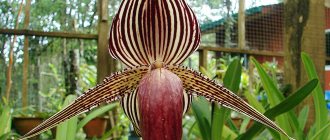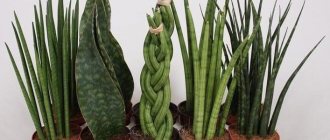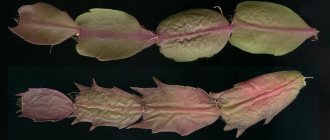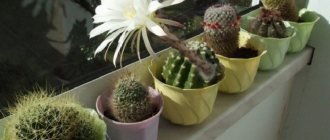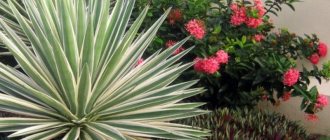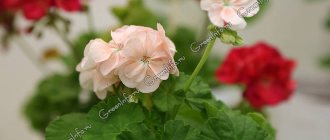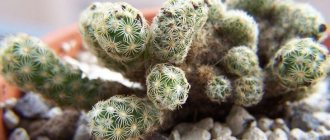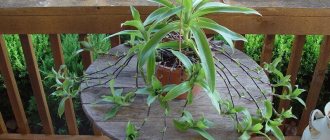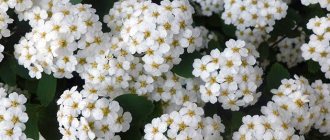Home care
- Lighting
Sansevieria golden hunny prefers bright light , responds well to open sun, and only on the nicest sunny days on the south side will it need to be shaded. On northern windows and in winter it is good to organize additional lighting.
With the optimal amount of light for these varieties, the general species “pike” pattern appears brighter, as well as white and yellow stripes on variegated forms.
- Temperature
The optimal summer temperature range is from 20 to 25 degrees , spring and autumn - 18-20 degrees , and in winter , during the dormant period - 15 degrees . Sansevieria hanni will survive a short-term drop to plus 10 degrees; but already at plus five to eight degrees the plant may die.
- Soil composition
Good growth will be provided by ready-made soil for cacti and succulents .
You can also prepare one of the following mixtures : three parts of leaf soil, two of turf and two of coarse sand; four parts turf, two parts leaf soil and one part sand.
What does Sansevieria Hanni look like, what family does it belong to?
Sansevieria Hahnii belongs to the group of asparagus subspecies. This is a perennial plant, which is considered to be native to the arid regions of Africa.
The flower has a very compact shape. The height of the dark green leaves rarely reaches 30 cm. The plant type is “rosette”, the flower size is small.
Sansevieria Hanni
Common varieties
There are more than 50 species of a wide variety of varieties of this type of plant. A brief description of the most famous ones is given below.
Sansevieria golden gets its name from its yellow leaves. Like other members of the genus, Sansevieria Golden Honey is a perennial plant. The leaves are fleshy and short. The color saturation of the leaf plate directly depends on the illumination of the flower.
Sansevieria Gold
The Silver variety is characterized by a silvery leaf color. The stripes are located across, and not along, as on other plants. Visually, this subspecies looks like a beautiful vase with leaves curved outward. The width of the leaf plate can reach 5-6 cm.
Sansevieria Silver
Sansevieria Hahnii Favorite differs from other representatives in its bright yellow color. The green stripes on the leaf are very thin, but the yellow color predominates. Sometimes the prefix Gold is added to the name Hunny Favorite. The root system of this sansevieria is very compact and superficial.
Landing
The container for planting Sansevieria hanni should be chosen to be ceramic, wide and shallow, corresponding to the dimensions of the plant. You can be guided by this ratio: the diameter of the pot is twice its height. There must be a drainage hole .
A drainage layer must be placed at the bottom of the planting container: small pebbles, expanded clay, broken bricks with pieces of charcoal. This layer should be thicker the younger the plant and can fill up to a third of the volume of the pot.
When planting, pay special attention to the preservation of the root system, trying to preserve the earthen ball.
- Transfer
Sansevieria hanni are replanted in the spring, in March-April . The signal for replanting is the complete entanglement of the soil with roots. Young plants give such a “signal” annually , more mature ones – once every 2-3 years .
Before transplanting, stop watering, plant in moist soil, and do not water immediately after transplanting.
- Watering
In summer, it is enough to water Sansevieria hanni once a week , and in winter - once a month . This is exactly the case when it is better to dry it than to over-moisten it.
Deciduous plants are especially protected from the ingress of irrigation water: stagnation of moisture in it leads to root rot, which will destroy the plant.
Dry air is preferable; spraying is not necessary ; you just need to periodically wipe off the dust from the leaves.
- Top dressing
During the period of active growth of sansevieria, in spring and summer, fertilizing is carried out once every two weeks with a specialized mixture for cacti and succulents .
If complex fertilizers are used, you need to take into account that they should not contain an excess of nitrogen compounds and this complex must be dissolved in a much larger amount of water than for other plants.
- Trimming
This operation is applied only to damaged leaves. They usually dry out and then such an area should be cut off, leaving a narrow dry border so that the process stops.
- Bloom
Sansevieria hanni can bloom at any time of the year - with small star-shaped flowers on an elegant peduncle. This peduncle needs to be trimmed after flowering.
To encourage the plant to flower, it is transplanted into a tight pot, only 4-5 cm wider than the previous one.
How to properly transplant a pike tail
Description and features of growing strong gold tulip
Transplantation and choice of container for sansevieria is determined by the characteristics of its growth rate, as well as the direction of growth of the root system.
Choosing a pot and soil requirements
Like many other succulents, sansevieria needs well-drained soil. To do this, a sufficiently large layer of sand is laid on the bottom (from 1/3 to 1/4 of the total volume). You can add peat to it by mixing the materials in equal quantities. The composition of the soil is typical for such plants:
- leaf soil;
- layer of sand;
- peat.
These materials are selected in approximately equal volumes. You can also add humus (no more than 20% of the total mass).
As for choosing a pot, it is best to choose a shallow and at the same time wide dish. This is due to the fact that the roots of the mother-in-law’s tongue grow in width, but they practically do not develop in depth. There are no fundamental requirements for the container material. However, ceramic pots with fairly thick walls are often used for it. An explanation for this will be given in the article a little later.
How and when to transplant mother-in-law's tongue
Sansevieria rarely needs to be replanted, since the growth rate of the shoots is not too high. If the plant is young, then first it should be replanted once a year or a year and a half, and then once every 3 years. If the bush has reached too large a size, you can divide it and plant it in 2 pots respectively.
Important! The root system of this plant is very powerful, and if it is not transplanted into a larger container in time, the roots are quite capable of literally tearing the pot apart
Reproduction
At home, this Sansevieria variety is propagated by root division and cuttings. It should be taken into account that the variegated forms - hunny golden and hunny silver - will lose their color when propagated by cuttings . To preserve it, these varieties are propagated exclusively by dividing the rhizome.
- Propagation by dividing rhizomes
During spring transplantation, the extracted rhizome is cut into pieces with a sharp instrument. Each segment must have at least one growth bud. The sections are treated with fungicide or crushed charcoal and parts of the rhizome are planted in separate containers of appropriate sizes.
- Propagation by cuttings.
For such propagation, you need to select a mature leaf, cut it off, lay it with the bottom surface up and divide it with a sharp knife in the transverse direction into pieces from five to seven centimeters long. These leaf cuttings are withered for some time, then planted in moistened sand, buried a third of the length, and covered with plastic film. Moderate watering is carried out through a tray, and the greenhouse is regularly ventilated. Rooting, as a rule, occurs after one and a half to two months. Then the cuttings are grown by planting them in a standard soil mixture for sansevieria.
Sansevieria: types of flower
The following varieties are very popular among gardeners.
Sansevieria three-lane
Sansevieria trifasciata is the most popular of its kind. One has only to speak the mother-in-law’s language, and everything immediately becomes clear.
Description of the appearance of the flower:
- the leaves are long, fleshy, pointed at the end, dark green in color with transverse dark stripes;
- there is no stem, all leaves emerge from the rosette;
- The flowers are small, white, fragrant, and are collected in panicle inflorescences.
Sansevieria trifasciata
The main varieties of Sansevieria (Sansevieria) three-lane:
- Compacta is a hybrid of the Laurenti variety, which is characterized by beautiful, decorative leaves, effectively curved inward, giving the impression of a three-dimensional basal rosette. It grows slowly. To preserve the characteristics of the variety, propagation can only occur by dividing the rhizome. Requires moderate watering and does not tolerate excess moisture;
- Jade is a hybrid of the Hanni variety, which is found only in the collections of those who professionally breed these flowers. It is characterized by medium-sized rosettes, low pointed leaves, slightly deviating outward, and a uniform rich green color. Unlike most members of the species, Jade does not bloom;
- Sansevieria (pike tail) Robusta is distinguished by dense rosettes of short, wide green leaves with longitudinal dark stripes;
- Sansevieria Black Gold is a variety that appeared not very long ago. These plants have about 10 long, narrow leaves with a blue tint;
- Sansevieria Futura Superba is a hybrid of the new Fututra variety. Despite the fact that it appeared recently, it has already gained popularity among lovers of indoor floriculture. The rosette consists of 10 or more light green leaves. Their height reaches half a meter, and their width reaches 10 cm. The leaves are hard, even tough. From the same group is another new, but low-growing variety of sansevieria - Gold Vedi;
- Silver Queen is a hybrid whose leaves are long and thin, gray-blue in color with a silver tint (these are rare colors that were bred by breeders quite recently). The entire leaf blade is covered with dark green watercolor spots. There is a slightly noticeable border along the edges, emphasizing the main color. This variety also has a popular name. He was nicknamed "the snow queen".
Variety Jade
Sansevieria cylindrica
The cylindrical variety is characterized by original twisted leaves that look like elongated cylinders (hence the name). The plant is beloved by gardeners because its above-ground part is intertwined, creating original shapes.
Note! You can also obtain compositions artificially by independently directing the shoots in the right directions
Variety Mikado
Popular varieties:
- Mikado is a sansevieria that is not very common and is practically unknown to lovers of indoor floriculture. Its leaves are thick and tall, green in color with transverse dark stripes. Another name is Bacularis;
- Sansevieria Bonselensis is the owner of voluminous cylindrical leaf plates arranged in a fan shape. The color is green, the cylinders are covered with a slight waxy coating, and standard dark stripes run across;
- Sansevieria Samurai is distinguished by short leaves about 10 cm long and about 3 cm wide. The leaf shape is triangular. This is a low-growing flower, growing to a maximum of 20 cm. The second name of the variety is Dwarf.
Variety Samurai, or Dwarf
Sansevieria large
Grandis sansevieria is the largest of all its relatives. The leaves are very long (up to 1.5 m) and wide. Thanks to its impressive size, it has earned the popular nickname “elephant ears.” Dark zigzag patterns run along the green leaf blades, and the edges are edged in red. This is a flowering variety; the buds are located on a large, tall stem and collected in wide clusters.
Popular varieties:
- walking (Pingvecula) has an unusual property for all sansevierias - it forms a kind of trunk on which leaves of an original shape are placed. They are large, sharp at the ends and have a thin border. Rosettes are located on shoots extending from the main trunk. Due to this, it seems that the flower is walking;
- Sansevieria Franzisi is one of the stem varieties with creeping shoots, which are quite rare. Tubular, cylindrical leaves extend from the main trunk. Their color is dark green and their texture is not smooth but slightly rough. The length of the plant reaches 60 cm. It will look most impressive in hanging flowerpots, where the flower will look like an ampelous one.
Signals of trouble
The leaves turn yellow - a sign of waterlogging, stagnation of water in the leaf rosette. A replantation is required, removing damaged leaves and drying the roots.
Sansevieria does not grow - as a rule, this is a consequence of too low temperatures.
Leaves with whitish spots are signs of sunburn.
Brown spots on the leaves are a sign of lack of light and excess moisture.
Leaf rotting in dry soil - the plant is kept in the cold.
Red-brown spots with a yellow border are a fungal disease.
Diseases and pests
If Sansevieria hanni is kept in more or less suitable conditions, it practically does not suffer from diseases and pests.
However, without receiving proper, not at all complicated, care, first of all, being in cold and damp conditions, the plant loses its inherent immunity and is affected by rot and fungal infections . In such cases, you should remove the affected parts, treat the cuts with fungicides, dry the roots, plant them in fresh soil and keep the plant in a warm room, watering very moderately.
spider mites or thrips can settle on it . They can be removed immediately with a soap solution, but the most effective means of combating these insects are systemic insecticidal preparations.
“Pike tails” - Sansevieria are among the most resistant plants in indoor culture. With sufficient lighting, not too low temperatures and limited watering, they retain their discreet decorative appearance for many years. In addition, well-groomed miniature rosettes of Sansevieria hanni - unpretentious inhabitants of bright window sills - not only decorate the interior, but also purify the air in the room where they are located from toxic substances such as formaldehyde and nitric oxide.
Varieties
One of the most popular varieties of Sansevieria is "Skyline". It has an unusual shape: the leaves are directed to the sides so that they form an eight-rayed star. Being an excellent decorative element, “Skyline” also acts as a filter, purifying the air from chemical pollutants and various bacteria.
Sansivieria "Velvet Touch" can be identified by the presence of leaves looking straight up, reminiscent of a picket fence. It is also able to process carbon dioxide and harmful impurities contained in the air.
"Bonselenzis" has thick leaves that look like a fan, the length of which ranges from 10 to 30 centimeters. Sansivieria "Spaghetti" is characterized by the presence of peak-shaped leaves, which in fact bear little resemblance to real spaghetti.
Photo
See more photos of Sansevieria hanni below:
Sansevieria is an unpretentious and tenacious plant and a real find for beginning gardeners. We recommend reading our articles about existing plant species, as well as the cultivation and propagation of Velvet Touch, Moonshine, three-strip and cylindrical varieties.
